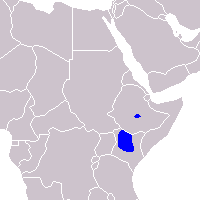Grevy's Zebra
2007 Schools Wikipedia Selection. Related subjects: Mammals
| iGrevy's Zebra | ||||||||||||||||
|---|---|---|---|---|---|---|---|---|---|---|---|---|---|---|---|---|
 |
||||||||||||||||
|
|
||||||||||||||||
| Scientific classification | ||||||||||||||||
|
||||||||||||||||
|
|
||||||||||||||||
| Equus grevyi Oustalet, 1882 |
The Grevy's Zebra (Equus grevyi), sometimes known as the Imperial Zebra, is the largest species of zebra. It is found in the wild in Kenya, Somalia, and Ethiopia, and is considered endangered, partly due to hunting for its skin, which fetches a high price on the world market. Compared to other zebras, it is tall, has large ears, and its stripes are narrower. The species is named after Jules Grévy, a president of France, who, in the 1880s, was given one by the government of Abyssinia.
The Grevy's Zebra differs from all other zebras in its primitive characteristics and different behaviour. In fact, "zebra" does not describe any specific taxon and is used only to refer to black and white striped members of the family Equidae. All members of the family are of the genus Equus, but the genus is commonly subdivided into four subgenera; Equus, Asinus, Hippotigris and Dolichohippus. The plains and mountain zebras belong to Hippotigris, but the Grevy's is the sole species of Dolichohippus. In many respects the Grevy's zebra is more akin to the asses (Asinus) while the other zebras are more closely related to the horses (Equus). In certain regions of Kenya, the Plains and Grevy's Zebras coexist.
Grevy's zebra is the largest of all wild equines. It is 2.5-3 m from head to tail with a 38-75 cm tail, and stands 1.25-1.6 m high at the shoulder. Males weigh 380-450 kg, and females 350-400 kg. The stripes are narrow and close-set, being broader on the neck, and they extend to the hooves. The belly and the area around the base of the tail lack stripes. With all of the stripes closer together and thinner than most of the other zebras, it is easier to make a good escape and to hide from predators. The ears are very large, rounded, and conical. The head is large, long, and narrow, particularly mule-like in appearance. The mane is tall and erect; juveniles having a mane extending the length of the back.
Grevy's Zebra is similar to the asses in many ways. Behaviourally, for example, it has a social system characterised by small groups of adults associated for short time periods of a few months. Adult males spend their time mostly alone in territories of 2-12 km², which is considerably smaller than the territories of the wild asses. The territories are marked by dung piles and females within the territory mate solely with the resident male. Small bachelor herds are known. This social structure is well-adapted for the dry and arid scrubland and plains that Grevy's Zebra primarily inhabits, less for the more lush habitats used by the other zebras. Like all zebras and asses, Grevy's Zebra males fight amongst themselves over territory and females. The Grevy's is vocal during fights (an asinine characteristic), braying loudly. Otherwise, the Grevy's communicates over long distances.
The Grevy's Zebra lives 10-25 years and eats grasses and other plants. Gestation lasts 350-400 days, with a single foal being born. Predators of Grevy's Zebra include hunters and wild dogs native to the area. Most captive zebras in zoos are Grevy's Zebras .



